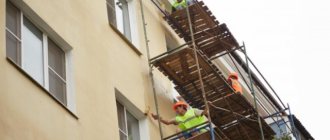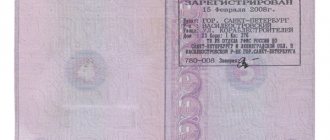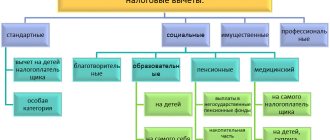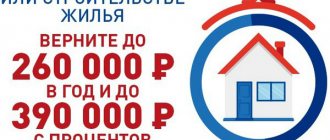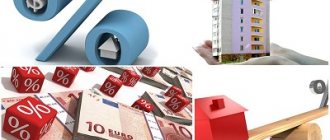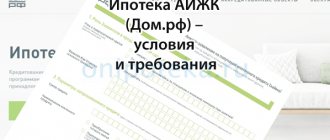Who is entitled to a deduction for finishing an apartment and when?
Tax deduction for finishing expenses refers to property deductions. It can be obtained on the basis of paragraphs. 4 p. 3 art. 220 of the Tax Code of the Russian Federation along with a deduction for the purchase of real estate. The most important condition is to have an official income and regularly pay the 13% personal income tax.
To receive a deduction for finishing, special conditions must be met:
- the property was purchased at the development stage;
- the object is housing (house, apartment, room or share);
- There is no finishing when purchasing.
In paragraphs 5 paragraph 3 art. 220 of the Tax Code of the Russian Federation there is a direct indication that a deduction for finishing is possible only for “unfinished construction” real estate. Even if you buy housing from a developer, but in a finished house, the tax office will refuse a deduction for finishing costs.
When buying an apartment, you cannot get a tax deduction - none at all, and not just for finishing. This is a special format of real estate, which is legally considered non-residential premises. Property deductions do not apply to apartments.
If you intend to receive a tax deduction, make sure that the contract with the developer stipulates the absence of finishing. The tax office clearly distinguishes between the concepts of “finishing” and “repair”, so be careful with the wording, otherwise you may get a refusal.
Tax deduction for real estate renovation costs
Article No. 220 of the Tax Code of the Russian Federation clearly regulates those expenses on which personal income tax can be returned. Costs associated with purchasing real estate include:
- amount for the purchase of real estate, including a room or share;
- expenses for the purchase of materials for finishing the property;
- money for finishing the property, including the creation of design documentation and the conduct of repair work.
Registration of a personal income tax refund for expenses associated with the renovation of real estate is available only when the contract, which is the basis for this purchase, states that the construction of the property has not yet been completed, or that the apartment or room has not yet been finished, or has been delivered with rough finishing.
A citizen can simultaneously apply for a deduction both for part of the expenses incurred for finishing the property and for its purchase. In this case, a deduction can be made regardless of whether the apartment or room was renovated before the citizen received a certificate of ownership or not. The general rule for obtaining a property deduction also applies: the owner cannot receive more than 260,000 rubles.
How much can I get back?
The deduction for finishing is included in the general property deduction of 13% when purchasing an apartment, the maximum amount of which is 260 thousand rubles. This amount includes both the return of the cost of housing and the money spent on finishing. The amount of expenses for both together should not exceed 2 million rubles.
Example
The apartment was purchased for 1.6 million rubles; 400 thousand rubles were spent on finishing. The total was 2 million rubles. The tax deduction will be 13% of these expenses - 260 thousand rubles. If the finishing cost 600 thousand rubles, the total amount of deductible expenses would still remain the same - 2 million rubles, as well as the amount of the deduction - 260 thousand rubles.
When apartment buyers are married and receive official income, each spouse has the right to a tax deduction of 2 million rubles, for a total of 4 million rubles. This feature can be used to increase the amount of your deduction.
Example
The apartment was bought by a married couple for 3.2 million rubles. We spent 800 thousand rubles on materials and finishing work. Each spouse has the right to apply for a deduction of 50% of the costs of purchasing housing (1.6 million rubles) and the costs of finishing (400 thousand rubles) - a total of 4 million rubles. The 13% tax deduction in this case will be 520 thousand rubles.
What is included in the deduction calculation
The maximum tax deduction for the purchase of an apartment is 2,000,000 rubles. It may include the following expense items:
- the cost of purchased housing;
- costs associated with finishing;
- mortgage loan for the purchase of a home.
As a result of adding these points, there is a deduction amount from which the applicant is returned 13%. This means that it is advisable to claim a deduction for the renovation of an apartment only if the cost of its purchase does not exceed two million rubles.
Let's look at an example. The cost of the purchased housing was 1,400,000 rubles. It took 300,000 rubles for finishing. The amount of the tax deduction in this case will be (1,400,000+300,000)*13%=221,000 rubles.
When purchasing a property worth more than two million rubles, there will be no deduction for finishing work, so when carrying out repairs there is no point in collecting payment documents.
Thus, expenses for completing work on finishing the premises and purchasing materials for repair work are subject to reimbursement.
According to OKVED, finishing works for which costs will be reimbursed in the future include:
- installation of windows and doors;
- performing painting, plastering and tiling works;
- wallpapering walls or applying whitewash;
- laying tiles;
- installation of floors;
- glass works;
- installation of kitchen units, built-in cabinets, internal stairs.
Attention! The purchase of materials item includes the costs of purchasing consumables required to carry out the listed work.
Lawyers emphasize that the legislation establishes a clear list of works, the cost of which cannot be compensated. These include:
- purchase of interior items;
- electric installation work;
- installation of plumbing equipment
- redevelopment of the premises;
- acquisition of construction tools;
- installation and removal of metal-plastic windows;
- design services.
How to properly account for finishing costs
Not all repair costs are accepted as a property deduction for finishing, but only those specified in paragraphs. 4 p. 3 art. 220 of the Tax Code of the Russian Federation. For the rest, a tax refund will not be issued.
| Ka | |
| – for the purchase of finishing materials; – for work related to the finishing of an apartment, room or share(s) in them; – for the development of design and estimate documentation for finishing work. | – to develop an interior design project; – for the purchase of furniture, appliances and plumbing; – for the purchase of construction and power tools; - for redevelopment and reconstruction. |
The problem is that the tax code does not have an exact list of materials and work related to finishing an apartment. It is best to focus on section 43.3 “Construction finishing works” of the General Classifier of Types of Economic Activities (OKVED).
Section 43.3 of OKVED specifies the following works:
- polishing;
- plastering and painting works;
- covering floors and walls (tiles, parquet, carpet, wallpaper, etc.);
- scraping of floors;
- finishing carpentry work;
- soundproofing works;
- cleaning of the external area;
- installation of doors, windows, door and window frames.
A deduction can be issued for the costs of installing prefabricated kitchen units, as well as cabinets and stairs. There is no information about other pieces of furniture in the classifier, so, most likely, the tax office will refuse to take them into account.
general information
The deduction for the purchase of property consists of three parts and is provided for expenses:
- For new construction or acquisition on the territory of the Russian Federation of residential real estate (shares in them), land plots for them;
- To repay interest on targeted loans (credits) received from Russian organizations or individual entrepreneurs, actually spent on new construction or acquisition on the territory of the Russian Federation of housing (share(s) in it), a land plot for it;
- To repay interest on loans received from Russian banks, for refinancing (on-lending) loans (credits) for the construction or acquisition of housing (share(s) in it), a land plot for it, on the territory of the Russian Federation.
2 000 000 the maximum amount of expenses for new construction or purchase of housing on the territory of the Russian Federation, from which a tax deduction will be calculated.
In case of acquisition of property after January 1, 2014, the deduction limit applies to expenses incurred for the acquisition of one or several real estate properties.
3 000 000 rubles – the maximum amount of expenses for the construction and purchase of housing (land for it) when repaying interest on targeted loans (credits).
The limit on the amount of interest paid on targeted loans (credits) accepted for deduction applies to loans (credits) received after January 1, 2014. The amounts of interest paid on targeted loans (credits) received before 2014 can be included in the property deduction in full without any restrictions. If the taxpayer has exercised the right to receive a property tax deduction not in full, the remainder of the deduction can be carried forward to subsequent tax periods until it is fully used (clause 2, clause 1, article 220 of the Tax Code of the Russian Federation). The expenses taken into account when calculating the property tax deduction include:
- For new construction or acquisition of a residential building (shares/shares in it) on the territory of the Russian Federation:
- development of design and estimate documentation;
- purchase of construction and finishing materials;
- the actual acquisition of a residential building (share(s) in it), including at the stage of unfinished construction;
- construction (completion) and finishing works or services;
- organization of electricity, water and gas supply and sewerage (including autonomous) at a residential property.
- When purchasing an apartment or room (shares/shares in them) on the territory of the Russian Federation:
- the actual purchase of an apartment or room (shares/shares in them);
- acquisition of rights to an apartment or room (shares/interests in them) in a house under construction;
- purchase of finishing materials;
- work related to the finishing of an apartment or room (shares/shares in them), including the development of design and estimate documentation for finishing work.
Acceptance for deduction of expenses for the completion and finishing of an acquired house or finishing of an acquired apartment or room is possible only if the relevant agreement specifies the acquisition of an unfinished residential building, or an apartment or room (rights to them) without finishing.
Other expenses, in addition to those listed, are not taken into account as part of the property deduction, for example, expenses associated with the redevelopment and reconstruction of premises, the purchase of plumbing and other equipment, registration of transactions, etc.
The home purchase deduction does not apply in the following cases:
- if payment for the construction (purchase) of housing was made at the expense of employers or other persons, funds from maternal (family) capital, as well as from budget funds;
- if the purchase and sale transaction is concluded with a citizen who is interdependent in relation to the taxpayer.
Interdependent persons are recognized as: an individual, his spouse, parents (including adoptive parents), children (including adopted children), full and half brothers and sisters, guardian (trustee) and ward (Article 105.1 of the Tax Code of the Russian Federation).
When purchasing property in common shared ownership before January 1, 2014, the amount of the deduction is distributed among the co-owners in accordance with their share/shares of ownership. In the case of property acquisition after January 1, 2014, the distribution of the amount of deduction in the case of the acquisition of housing in common shared ownership has been cancelled. Property deduction is provided in the amount of actual expenses incurred by each of the co-owners within the overall established deduction limit.
At the same time, parents who have minor children and purchase housing in common shared ownership with them have the right to apply a property deduction without distribution by shares.
If housing was purchased under an exchange agreement with an additional payment, this is not a reason for refusing to receive a property deduction, since the Tax Code does not prohibit this option for purchasing housing. Property acquired by spouses during marriage is their joint property, so they both have the right to deduction, including the right to distribute it as agreed.
Advantages and disadvantages compared to a consumer loan
The main advantages of a renovation mortgage compared to a regular consumer loan are:
- low interest rate;
- receiving a large sum at once by providing collateral to the bank;
- long loan terms (up to 30 years);
- no need to purchase insurance (some banks do not require you to enter into an insurance agreement).
Despite the indicated advantages, a mortgage loan for home renovation also has significant disadvantages in comparison with consumer loans. Disadvantages include:
- the intended purpose of the loan (the bank strictly controls that the allocated money can only be spent on repair and construction work, the purchase of materials and furniture);
- the presence of additional expenses on the part of the borrower (fees for registering a transaction, valuation of the collateral, etc.);
- application of the collateral coefficient even to new apartments (on average its value is 0.5 - that is, the client will be able to receive no more than half of the value of the property);
- increased risk of loss of existing property (most consumer loans are issued without any collateral and do not carry high risks, unlike a mortgage).
Is it possible to take out a mortgage to renovate an apartment on favorable terms and in which banks?
Interest rates for this type of mortgage lending are lower than for consumer loans, the amounts are larger, and the repayment terms are longer.
Non-targeted mortgage loans secured by an apartment are offered by Sberbank, VTB and other banks . The longer the terms and amount of the loan, the higher the interest rate.
How to confirm expenses
The tax office will require documentary evidence of finishing costs, so during the renovation process you need to carefully record all costs of materials and work. The following can be presented as evidence:
- sales and cash receipts (paper and electronic);
- contracts and estimates;
- Bank statements;
- payments and receipts.
The costs of the services of craftsmen will be taken into account when drawing up an official contract for finishing work - preferably with a detailed estimate. As a last resort, you can issue a receipt. Work under an oral agreement without confirmation of payment will not be included in the tax deduction.
The documents must contain the details of construction organizations and individual entrepreneurs, stamps and signatures. If the contract is concluded with an individual, it is necessary to indicate his passport details.
When drawing up estimates and other documents that indicate finishing work, you must definitely check section 43.3 of OKVED - the names must match. The tax office can find fault with even such a trifle and deny a deduction for finishing.
Tax refund for apartment renovation
The right to income tax compensation for apartment renovation is provided for by the Tax Code of the Russian Federation, Art. 220. Clarifications on this issue were made by letters from the Federal Tax Service and the Ministry of Finance.
In a new building
There is a typical situation in the real estate market - the sale of apartments from the developer in new buildings with rough finishing.
In this regard, owners of brand new apartments have to spend a lot of money on repair work. Pleasure is not cheap, so the Tax Code provides for the right of citizens to receive a tax deduction on this basis.
But this opportunity does not apply to all real estate properties. A tax deduction for apartment renovation can be obtained subject to the following conditions:
- The housing was purchased directly from the developer; the contract must include the wording: “unfinished apartment.”
- The documents must indicate that the property was sold without renovation. If partial repair work has been carried out, this fact must be recorded in the contract.
- It is important to distinguish between the concepts of “repair” and “finishing”. Compensation is due for carrying out repair work on the property without finishing.
- Compensation is provided for carrying out a certain list of works.
The maximum amount with which a personal income tax refund can be issued is 2 million rubles.
There is no separate cost item for repair work. That is, if this limit was spent on purchasing housing, then there is no money left to deduct for repairs. But spouses can apply for compensation for two, in the amount of 4 million rubles, receiving 13% for both the cost of the property and for repairs.
We recommend additional reading: How many times can you get a property tax deduction when buying an apartment?
Secondary market
This rule does not apply to new housing, even if you purchased a “killed” apartment that requires major repairs to make it suitable for living.
Yes, sometimes secondary housing requires major repairs, with replacement of wiring, installation of floor coverings, installation of new doors and windows, that is, those expenses that are subject to reimbursement of 13% of the cost of costs.
But if we are talking about secondary housing, there is no deduction for reimbursement of repair costs.
How to apply for a deduction for finishing
We have already written articles about how to get a deduction when buying an apartment and when paying mortgage interest. Now let's talk about how to return 13% of the cost of finishing a home - the cost of materials and work.
The deduction for finishing is issued together with the property deduction when purchasing a home. The same rules apply - you need to contact the tax authorities at your place of residence directly, at the MFC or online through the “Personal Taxpayer Account”.
Documents confirming the right to deduction:
- agreement on the purchase of real estate (in this case it is a DDU);
- Act of Handover;
- payment documents (including confirmation of finishing costs);
- an extract from the Unified State Register of Real Estate (we wrote about it in detail in another article);
- certificate 2-NDFL (issued at work in the accounting department).
You can submit an application in two ways - through your employer or directly to the tax office by filling out the 3-NDFL declaration yourself. Let's figure out which option to ultimately choose in a given situation.
Procedure for receiving a deduction
To receive a property deduction at the end of the year, the taxpayer must:
- We fill out a tax return (form 3-NDFL).
2. We receive a certificate from the accounting department at the place of work about the amounts of accrued and withheld taxes for the corresponding year in form 2-NDFL.
3. We prepare copies of documents confirming the right to housing, namely:
- when constructing or purchasing a residential building - a certificate of state registration of the right to a residential building;
- when purchasing an apartment or room - an agreement on the purchase of an apartment or room, an act on the transfer of the apartment or room (share/shares in it) to the taxpayer, or a certificate of state registration of the right to the apartment or room (share/shares in it);
- when purchasing a land plot for construction or for finished housing (shares/shares in it) - a certificate of state registration of ownership of the land plot or share/shares in it and a certificate of state registration of ownership of a residential building or share/shares in it;
- when repaying interest on targeted loans (credits) - a targeted credit agreement or loan agreement, a mortgage agreement concluded with credit or other organizations, a schedule for repaying the loan (loan) and paying interest for the use of borrowed funds.
Since the issuance of a certificate of state registration of property rights has been discontinued since 2021, instead of it the taxpayer has the right to submit an extract from the Unified State Register of Rights to Real Estate and Transactions with It (USRP) as a supporting document.
4. We prepare copies of payment documents:
- confirming the taxpayer's expenses when purchasing property (receipts for receipt orders, bank statements about the transfer of funds from the buyer's account to the seller's account, sales and cash receipts, acts on the purchase of materials from individuals indicating the address and passport details of the seller and other documents) ;
- evidencing the payment of interest under a target credit agreement or loan agreement, mortgage agreement (in the absence or “burnout” of information in cash receipts, such documents can serve as extracts from the taxpayer’s personal accounts, certificates from the organization that issued the loan about the interest paid for using the loan).
5. When purchasing property for common joint ownership, we prepare:
- a copy of the marriage certificate;
- a written statement (agreement) on the agreement of the parties to the transaction on the distribution of the amount of the property tax deduction between the spouses.
6. We provide the tax authority at the place of residence with a completed tax return with copies of documents confirming actual expenses and the right to receive a deduction when purchasing property.
If the submitted tax return has calculated the amount of tax to be refunded from the budget, together with the tax return it is necessary to submit to the tax authority an application for a refund of personal income tax in connection with the costs of purchasing property.
Registration of deductions through the employer
The method is suitable for those who have a high income and want to start returning personal income tax immediately for the current year. In this case, the employer stops transferring 13% of the employee’s salary to the tax office and pays it taking into account this increase. If the income is high, then the deduction will also be appropriate.
What you need to do to apply for a deduction through your employer:
- Collect documents confirming the right to deduction.
- Receive notification of the right to receive a property tax deduction. This can be done in three ways - in person at the tax office through an application, at the MFC or online (section “Life situations” / “Request a certificate and other documents”). The document must be issued within 30 calendar days.
- Submit a notification to the employer’s accounting department with an application for a tax deduction.
As soon as they receive a notice from the tax office at work, they will begin adding a deduction to your salary every month. This document is valid for one calendar year (namely a calendar year, not a year from the date of receipt), after which it will need to be issued again.
Who can receive a tax deduction
Not all citizens who have committed actions from the list above are entitled to a deduction. In order for the Federal Tax Service to accept an application for consideration, the applicant must:
- be a citizen of the Russian Federation. Stateless persons and citizens of foreign countries cannot count on any payments in this area.
- pay income taxes correctly. This involves working with formal employment. Pensioners, women on maternity leave and workers receiving “gray” salaries will not be able to take advantage of this preference.
- be a home owner. The deduction is received only by the citizen who owns the apartment. Members of the owner's family registered in the living space do not have rights to payments. There can be several owners, each of them can receive a return. Proportional to the size of its share in the right of common ownership.
Refunds for real estate transactions are carried out once in a lifetime for citizens who used their right before 2014. For those who purchased housing after 2014, payments can be made repeatedly for this and subsequent transactions until the amount of payments reaches its limit. In 2021, the limit for the amount for which you can receive a tax deduction is two million rubles. Accordingly, the maximum amount will be 260 thousand rubles (13% of two million).
Self-filing of 3-NDFL declaration
When applying for a property deduction through the tax office, you can return personal income tax for the previous 3 years inclusive. For example, in 2020 you can receive a deduction for taxes calculated in 2021, 2021 and 2017. This is convenient for average and low salaries.
How to file a property deduction with the tax office:
- Collect documents confirming the right to deduction.
- Submit documents through the tax office with a completed 3-NDFL declaration or online (section “Life Situations” / “Submit 3-NDFL Declaration”).
- Wait for a response from the tax office - a maximum of 3 months from the date of filing the application.
If the deduction is approved, then after receiving a notification from the tax authorities, the money will be transferred as early as next month - the entire amount at once. The tax option is convenient because the deduction does not need to be filed every year - you can submit a return for 3 years at once.
Who can benefit
To be able to receive a property deduction for finishing the purchased home, the applicant must meet the following requirements:
- be a resident of the Russian Federation;
- have official employment with monthly income tax deductions - pensioners, unemployed students, women on maternity leave cannot apply for a deduction because they do not have income subject to income tax;
- be the owner of the purchased property - if there are several owners, the deduction is provided to the applicant with the consent of the remaining residents;
- have documents confirming the fact of paying for the apartment using your own or borrowed funds.
Memo - main points when receiving a tax deduction for finishing
- The tax deduction for finishing costs is included in the property deduction when purchasing real estate and is issued along with it.
- To receive a deduction, the property must be purchased, unfinished and not be an apartment, that is, non-residential premises.
- Due to the property deduction, you can return 13% of the costs for materials and finishing work, for the development of design and estimate documentation (maximum 260 thousand rubles or 520 thousand in total for spouses).
- All expenses must be supported by documents - checks, contracts and other documents.
- You can apply for a tax deduction yourself by filling out and sending the 3-NDFL declaration (return for the previous 3 years) to the tax office, or through your employer (for the current year).
What is a tax deduction
For those who do not quite understand what kind of deduction we are talking about and what it represents, we will conduct a small educational program.
A tax deduction is a refund of part of the tax paid, which the state returns to the taxpayer. The amount of refunds is established at the legislative level.
A tax deduction can be obtained when paying for education, treatment, buying real estate or a car, donating money to charity, paying interest on a mortgage, paying voluntary insurance or pension contributions, and other similar actions. For repairs made in an apartment purchased under a share participation agreement in construction, the state also practices the return of part of the funds paid.
Who can return personal income tax for repairs in a new building?
Citizens of the Russian Federation who:
- have an official job and receive a salary. That is, pensioners and people on “black” wages will not be able to receive a deduction;
- pay 13% income tax. Workers on maternity leave temporarily cannot claim a personal income tax refund for repairs in a new building, since child care benefits are not taxable;
- are the owners of the purchased apartment. That is, you cannot register housing, for example, in the name of your mother, and then issue a personal income tax refund.
For what finishing work can you get a tax refund?
Finishing works, the costs of which are subject to compensation from the state, include items from the list of information provided by OKVED.
Which finishing works are subject to partial compensation?
- Costs for the purchase of materials required for the construction and finishing process, supported by documents by submitting payment papers to the tax service. This list item includes almost any building materials.
- Construction work, that is: calculation of estimates;
- conducting communications and engineering networks;
- construction of extensions to the main part of the housing, if we are talking about a house;
- wall plastering and finishing;
- leveling and laying floors;
- other finishing and finishing works.
Note! All official documents submitted to the inspection must contain specific information confirming that the work being carried out is of a finishing nature.
As for the concept of “repair”, a refund for it is applicable only to secondary housing that was finished at the time of purchase. If incorrect wording is used, the tax service has every right to refuse a refund.
Conditions for granting deductions
A partial refund paid to the state budget by the taxpayer is due only when purchasing real estate in which the owner intends to live. In this case, the following condition must be met: it is necessary to indicate in the concluded contract for the purchase of housing that the transfer of funds for it has been completed, and to indicate the purchase amount.
Under what conditions is the deduction granted?
The calculation of the deduction is made on the basis of the financial base - the cost of housing and other costs incurred; in the case considered in this article, their role is the repair of a new building. If you decide to enter into an agreement with the seller and reduce the value of the purchased property in the documents, then you will receive a smaller deduction.
Not only finished housing is taken into account, but also self-built housing.
The list of costs available for compensation includes the following items:
- the amount paid for the purchased housing;
- expenses incurred for repairs, both capital and cosmetic;
- costs for the purchase of building materials and the work of the construction team when building a house or repairmen when carrying out the relevant type of work;
- purchasing a plot of land for construction is also on the list;
- a targeted loan taken from a bank, that is, a mortgage that will be used to purchase an apartment.
All of the above items are added up, subsequently making up the amount of the property tax deduction, which is the financial basis for calculating its amount.
Let's give an example. You and your family have long dreamed of buying a country house in a cottage village, but you did not have enough funds. Nevertheless, we decided to purchase a house with the help of a targeted loan.
At the beginning, you bought a plot of land in a country village for 700,000 rubles; on it stood an unfinished building worth one and a half million rubles. At the same time, you received a loan for one million from a banking organization and then you spent half a million to bring the building unfinished by the previous owners to completion. Let's calculate the amount of the tax refund due. To do this, we need to add up all the values we have, that is, 700,000 + 1,500,000 + 1,000,000 + 500,000 = 3,700,000 rubles. From this amount, you and your spouse can receive two deductions, one of which will amount to the maximum amount allowed when using a loan of 3 million rubles, and the second - 700 thousand, while the balance due to him will remain. In the first case, 13% of 3 million is due, that is, 390 thousand; in the second, 13% of 700 thousand, that is, 91 thousand.
If the amount of the mortgage loan was not one, but one and a half million, then the total cost would be more than four million - the maximum possible amount to cover, so you and your spouse would have to be content with only 13% of two million each, that is, 260 thousand.
Refunds for premises not provided for accommodation are not provided for by law. The list of these names includes:
- country houses;
- parking spaces;
- garages and other options.

